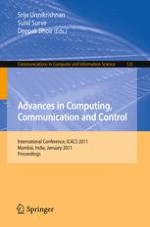This book constitutes the refereed proceedings of the International Conference on Advances in Computing Communications and Control, ICAC3 2011, held in Mumbai, India, in January 2011. The 84 revised full papers presented were carefully reviewed and selected from 309 submissions. The papers address issues such as AI, artificial neural networks, computer graphics, data warehousing and mining, distributed computing, geo information and statistical computing, learning algorithms, system security, virtual reality, cloud computing, service oriented architecture, semantic web, coding techniques, modeling and simulation of communication systems, network architecture, network protocols, optical fiber/microwave communication, satellite communication, speech/image processing, wired and wireless communication, cooperative control, and nonlinear control, process control and instrumentation, industrial automation, controls in aerospace, robotics, and power systems.
